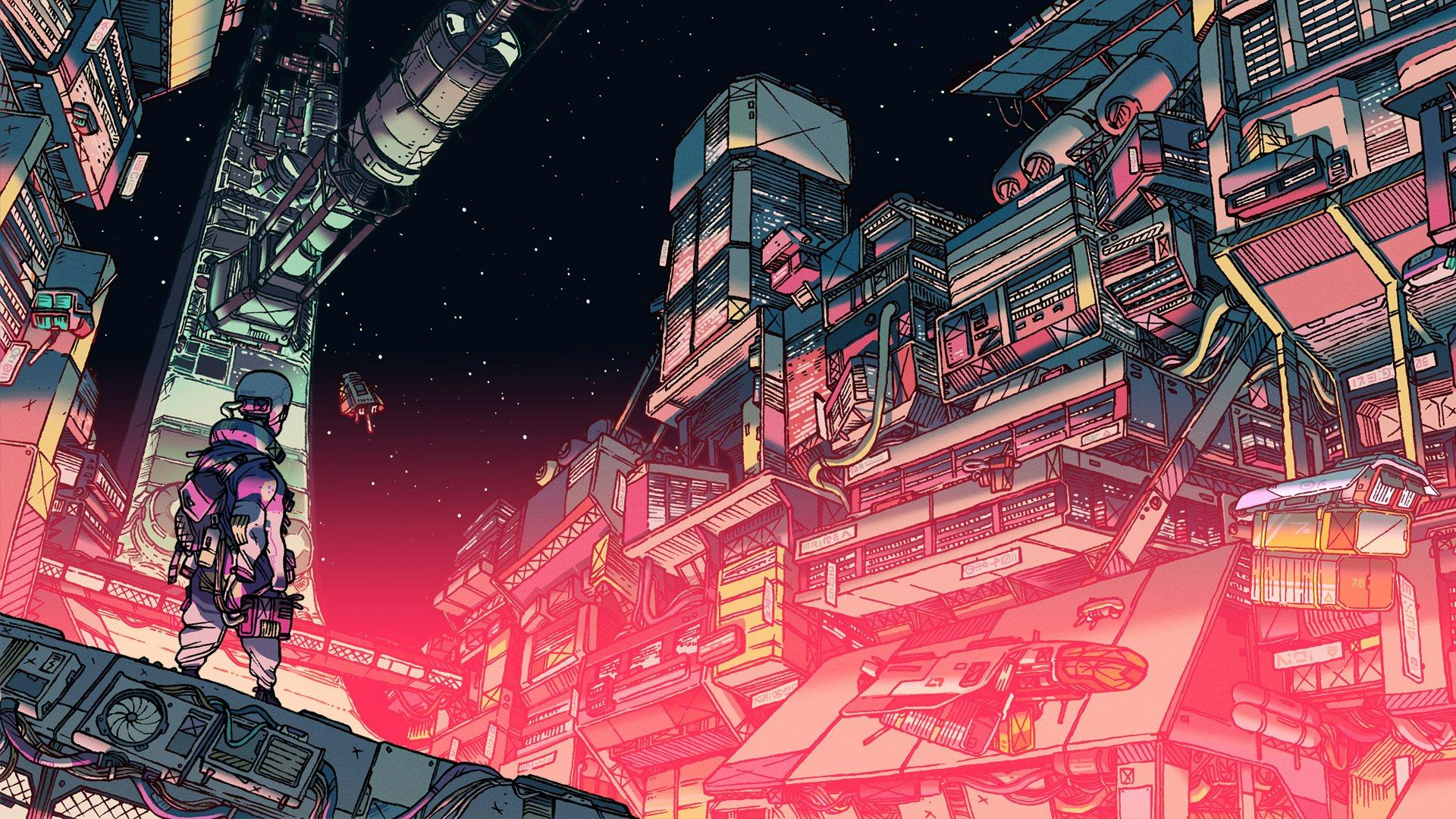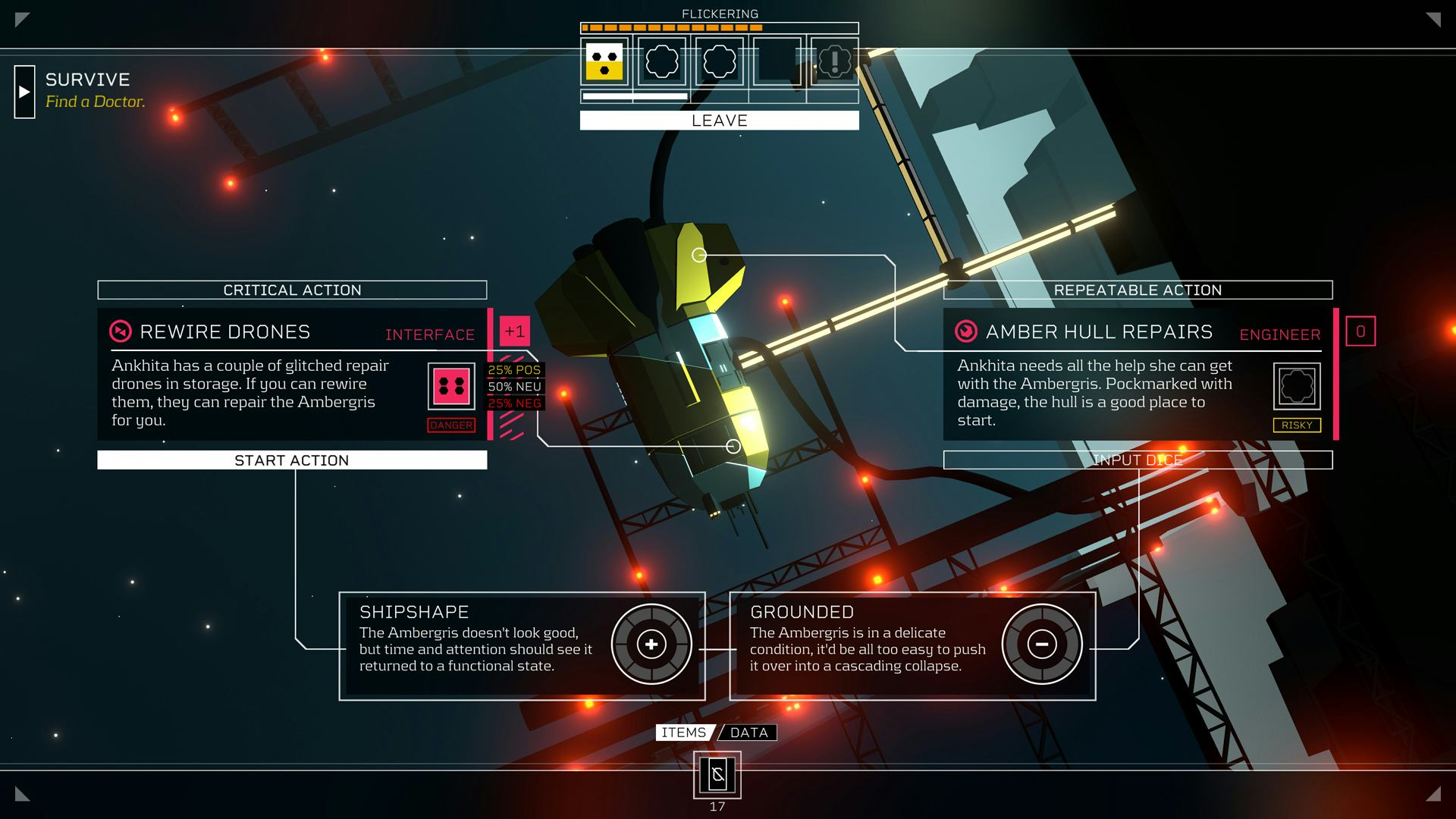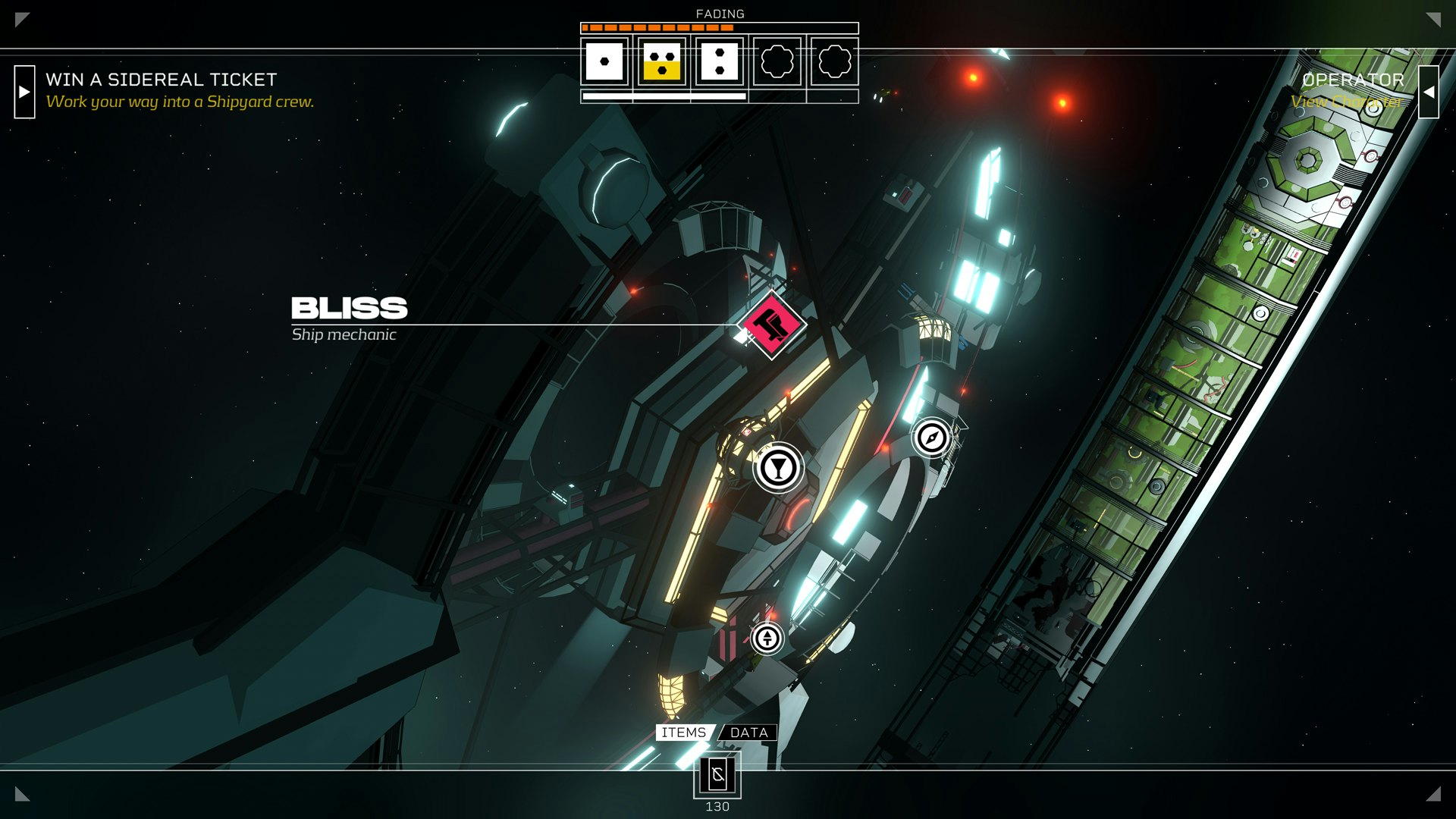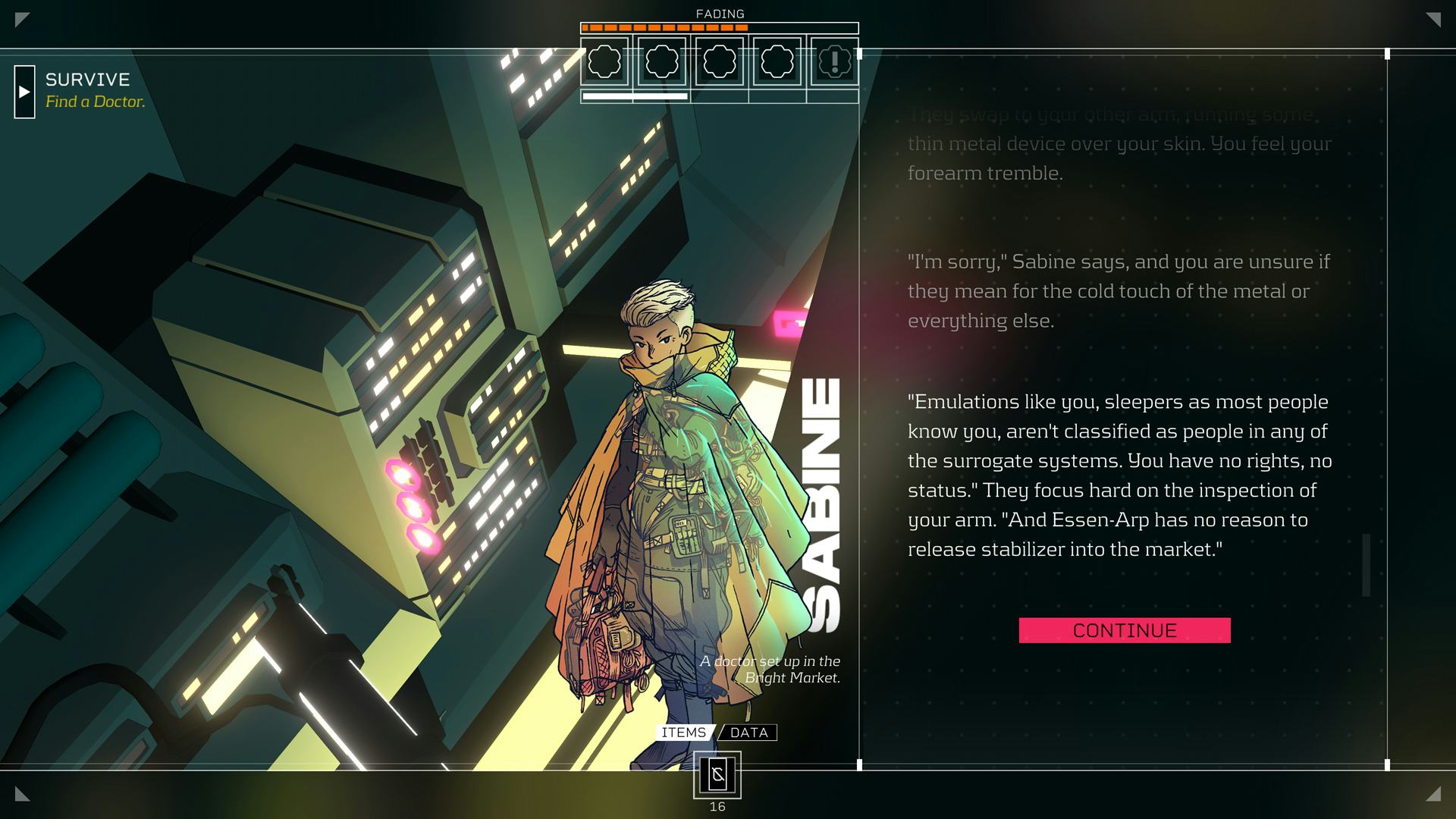
The massive circular space station known as the Eye hangs in deep space, still bearing the scars of a revolution.
Inside, glittering threads weave through its halls, linking the people of the Eye: mechanics, smugglers, refugees, and street cooks alike. These threads represent strings of data only you can see. Text messages, bank transactions, security logs are all there for you to sift through. In another way — metaphorical but more real than any digital receipt — these threads represent the connections between people. They represent how a commune of botanists helps the owner of a rundown bar achieve her dreams, how a community bands together when institutions inevitably screw them over, how a child nearly frozen solid in the vacuum of space can build a life worth living under the harsh artificial light of a ruined space station.
Citizen Sleeper from Jump Over the Age (developer of the 2020 cult hit In Other Waters) starts by showing you the web of data its characters are all caught in, gradually revealing that it’s also a net binding them together if they’ll only promise to catch each other when they fall.
Wake up, Sleeper
You start Citizen Sleeper by awakening in a freighter’s cargo hold fished out of the void of space by a scrap dealer. You survive the trip only by virtue of being a Sleeper — an emulated human consciousness stuffed into a robotic shell to be used as disposable labor for a hellish megacorp. From the beginning, your plan is simple and your options are clear. You’ve escaped from your corporate handlers and now must survive without a steady supply of the body-stabilizing substances they control to keep the Sleepers on a tight leash. Doing that means doing the bidding of any wandering soul aboard the Eye willing to pay in cash, food, or trust.

Citizen Sleeper spells out its simple mechanics in a few short tutorial messages. At the beginning of each day, you roll up to five dice, depending on your current condition. Nearly every action you perform spends one of these dice, whether you’re stealing security documents or chatting with locals, with higher rolls more likely to get you what you want. Some actions also spend condition or energy, two refillable resources that gauge your health and limit your ability to act. As a Sleeper, you also have access to the vast cloud of data suffusing the station which you can pull valuable secrets by spending a dice with a specific value.
From nodes on the game’s map, you spend your resources to complete quests ranging from corporate espionage to fast food delivery, trying to keep your head above water for one more day. Each quest you complete rewards you with an ability point used to upgrade your core stats or buy special abilities, though these usually feel like more of a side benefit to the real reward: the story.

Citizen Sleeper is mechanically sparse: I didn’t feel like I was interacting meaningfully with its world at first. My choices were usually driven by whatever I could accomplish with the dice in my hand, rather than being led by how I wanted my character to act. One of the best things about tabletop roleplaying games, from which Citizen Sleeper draws a lot of inspiration, is that failure is often more fun than success. A good gamemaster can turn a failed roll into a complication that ends up changing the game, or at least your character. Video games don’t have the luxury of improvisation, so failure usually just means losing resources or wasting time. For the first few hours of Citizen Sleeper, I was disappointed by these resource management systems, which were always demanding energy that could have been spent on more compelling tasks but never seemed to raise the stakes in an interesting way.
Weaving a web
What kept me invested was basically everything else. Citizen Sleeper makes a hell of an introduction. Its synthy score by Amos Roddy moves between downbeat bleakness and shimmering optimism (like the story itself), swelling to accompany major narrative beats, backed by the low hum of the space station. Within the game’s first moments, you also get your first look at Guillaume Singelin’s beautiful character art. Every character in the game is rendered in vivid color, everything from their outfits to their body language telling the story of their lives in a single glance.
From the start, Citizen Sleeper’s writing is excellent, and it only gets better as the game goes on. Descriptions of the Eye filtered through your emulated mind blend poetic mysticism with cyberpunk sci-fi, and the game’s dozen or so major characters are alive with personality and believable motivations. Helping someone doesn’t necessarily mean getting what you want; as complex people, everyone on the Eye has their own agenda. Furthering their goals may not always end well for you. Citizen Sleeper’s story continually gets more surprising and more philosophical, with huge events like the construction of a colony ship or the discovery of a new kind of sentience turning into treatises on community and the rights of those seen as less than people.

Citizen Sleeper is dotted with these world-changing events, often serving as points of emotional release at the end of long questlines. In these moments, Citizen Sleeper is a marvel. The music picks up, the writing gets punchier or loftier as the situation demands, your life and the lives of those around you are irrevocably changed. At its best, it feels both like reading a great sci-fi novel and playing in a well-realized tabletop campaign as threads of past events tie together, revealing new plot twists and allegories that lay under the game's words the whole time. But while you may thwart a corporate takeover of the station or lay a murderous rogue A.I. to rest, you are not the Eye’s savior or liberator. You, like the people you help, fight, or hide from throughout the game, are a citizen here, a member of the community pulling at the threads of your neighbors’ lives just as they pull at yours.
The choices that matter
The most impressive thing about Citizen Sleeper is how your progress through the game mirrors the Sleeper’s journey. At first, you’re alone, clueless about how the station runs, taking on odd jobs to survive. But with each task you complete, each character you come to know, the brilliant interconnectedness of life on the Eye becomes clearer. Characters as different as an itinerant worker and a shadowy information broker can affect each other’s lives in profound ways that even they may not be aware of. The more you try to assert control over your own path, the more you see how your choices are guided by chance, limited by hierarchy, and influenced by your relationships.

When I reached the credits of Citizen Sleeper, I looked back at those first underwhelming hours differently. The lack of choices I felt when getting adjusted to the station felt like a consequence of being trapped in a system far larger than myself, rather than an undercooked game mechanic, which only made the later moments when I was able to assert some agency more powerful. I still wish Citizen Sleeper’s resource management sold the fragility of your life on the fringes of space better, but its narrative stakes more than make up for its lack of mechanical ones. In the end, the choice of where to spend your limited dice rolls is far less interesting than the choice of whether to flee for some imagined safe haven or try to build a better life in a broken world among friends.
The story of Citizen Sleeper is one of the most thoughtful and emotionally satisfying I’ve ever played. Your story will be different, and I wholeheartedly recommend that you find out what it is.
8/10
Citizen Sleeper launches May 5 on PC, Xbox, and Nintendo Switch. Inverse reviewed the game on PC.
INVERSE VIDEO GAME REVIEW ETHOS: Every Inverse video game review answers two questions: Is this game worth your time? Are you getting what you pay for? We have no tolerance for endless fetch quests, clunky mechanics, or bugs that dilute the experience. We care deeply about a game’s design, world-building, character arcs, and storytelling come together. Inverse will never punch down, but we aren’t afraid to punch up. We love magic and science-fiction in equal measure, and as much as we love experiencing rich stories and worlds through games, we won’t ignore the real-world context in which those games are made.







